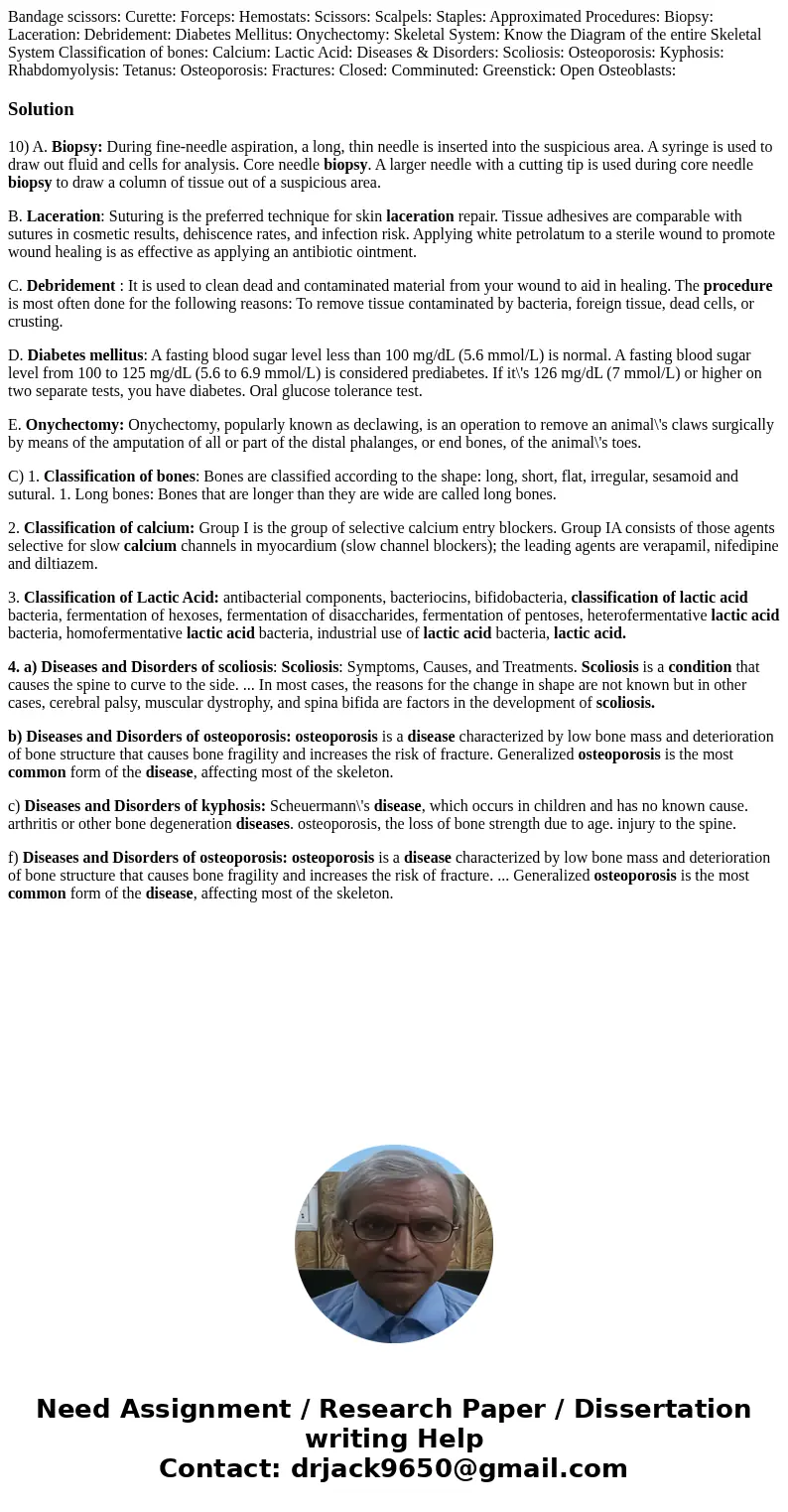Bandage scissors Curette Forceps Hemostats Scissors Scalpels
Solution
10) A. Biopsy: During fine-needle aspiration, a long, thin needle is inserted into the suspicious area. A syringe is used to draw out fluid and cells for analysis. Core needle biopsy. A larger needle with a cutting tip is used during core needle biopsy to draw a column of tissue out of a suspicious area.
B. Laceration: Suturing is the preferred technique for skin laceration repair. Tissue adhesives are comparable with sutures in cosmetic results, dehiscence rates, and infection risk. Applying white petrolatum to a sterile wound to promote wound healing is as effective as applying an antibiotic ointment.
C. Debridement : It is used to clean dead and contaminated material from your wound to aid in healing. The procedure is most often done for the following reasons: To remove tissue contaminated by bacteria, foreign tissue, dead cells, or crusting.
D. Diabetes mellitus: A fasting blood sugar level less than 100 mg/dL (5.6 mmol/L) is normal. A fasting blood sugar level from 100 to 125 mg/dL (5.6 to 6.9 mmol/L) is considered prediabetes. If it\'s 126 mg/dL (7 mmol/L) or higher on two separate tests, you have diabetes. Oral glucose tolerance test.
E. Onychectomy: Onychectomy, popularly known as declawing, is an operation to remove an animal\'s claws surgically by means of the amputation of all or part of the distal phalanges, or end bones, of the animal\'s toes.
C) 1. Classification of bones: Bones are classified according to the shape: long, short, flat, irregular, sesamoid and sutural. 1. Long bones: Bones that are longer than they are wide are called long bones.
2. Classification of calcium: Group I is the group of selective calcium entry blockers. Group IA consists of those agents selective for slow calcium channels in myocardium (slow channel blockers); the leading agents are verapamil, nifedipine and diltiazem.
3. Classification of Lactic Acid: antibacterial components, bacteriocins, bifidobacteria, classification of lactic acid bacteria, fermentation of hexoses, fermentation of disaccharides, fermentation of pentoses, heterofermentative lactic acid bacteria, homofermentative lactic acid bacteria, industrial use of lactic acid bacteria, lactic acid.
4. a) Diseases and Disorders of scoliosis: Scoliosis: Symptoms, Causes, and Treatments. Scoliosis is a condition that causes the spine to curve to the side. ... In most cases, the reasons for the change in shape are not known but in other cases, cerebral palsy, muscular dystrophy, and spina bifida are factors in the development of scoliosis.
b) Diseases and Disorders of osteoporosis: osteoporosis is a disease characterized by low bone mass and deterioration of bone structure that causes bone fragility and increases the risk of fracture. Generalized osteoporosis is the most common form of the disease, affecting most of the skeleton.
c) Diseases and Disorders of kyphosis: Scheuermann\'s disease, which occurs in children and has no known cause. arthritis or other bone degeneration diseases. osteoporosis, the loss of bone strength due to age. injury to the spine.
f) Diseases and Disorders of osteoporosis: osteoporosis is a disease characterized by low bone mass and deterioration of bone structure that causes bone fragility and increases the risk of fracture. ... Generalized osteoporosis is the most common form of the disease, affecting most of the skeleton.

 Homework Sourse
Homework Sourse